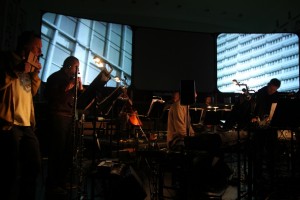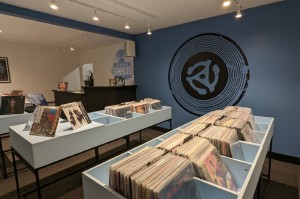Kraftwerk Uncovered: A Future Past
Nathan Richardson expects a tribute to Kraftwerk and instead discovers an evening of roaring, mesmeric experimentation…
“What’s past is Prologue” — William Shakespeare.
It is perhaps not much of an icebreaker when Icebreaker, the 12-piece musical ensemble performing Kraftwerk Uncovered: A Future Past last night at the Liverpool Philharmonic Hall – “a nostalgic vision of a ‘future’ now passed, and a modern reworking of a lost utopian dream” — announce that, for the first half, they shall be performing material of their own choice. Disappointed, confused sighs abounded, but as they began with their strange, fascinating, arresting sound, disappointment gave way to a sense of curiosity, and indeed enjoyment.
They started with Variations on a Theme by Casey and Finch, an avant-garde piece by the Swedish composer Erik Bünger which was inspired, he says, by skipping a CD; “The chorus line of the disco tune That’s The Way I Like It was chopped up into short fragments, the order of the fragments rearranged and the result written out as a score.” Clearly anybody expecting an evening in which The Model and Autobahn were given a quirky rendering in a live setting was in for something of a shock.
What in fact emerged was a piece of music – and it was a piece, in the classical sense, as these were certainly not ‘songs’ – not dissimilar to Steve Reich’s 1988 composition, Different Trains; stark, repetitive, perhaps even a little bizarre, but ultimately thrilling to witness, and in a symphony hall where the sound is exact. I watched on with intrigue and delight.
James Poke, leader of the orchestra, introduced the next part. It was Think Slow, Act Fast, a 1981 piece by the experimental pianist Michael Nyman. I began to wonder what exactly I’d let myself in for. Michael Nyman is but a name I am vaguely familiar with. I had expected, as I’m sure many had, a pleasant re-working of Kraftwerk material, and indeed on the afternoon before the gig I listened to The Man-Machine, arguably their most famous LP, to refresh my memory. I could not have been more ill-prepared.
Icebreaker test their audience: How far, they seem to ask, can you stretch the concept of music before it becomes just noise, and even so, can noise be considered music? Is all music but noise? It is obfuscating. This, I figure, was an event for your chin-stroking intellectual where the sound appeals as much to the mind as it does to the body, but that said, they truly are joyous live, and whether you ‘understand’ them or not, they are fabulous to watch.
Think Slow, Act Fast was my personal highlight of the evening – a roaring, mesmeric piece where cellos and panpipes, pianos and violins collided, repeating a simple progression, broken up with tinkling piano displays. It seemed to go on and on, and the musicians played with such bravura. I had no idea what was happening, but there was nevertheless a wide grin on my face, and I found it all so unspeakably marvellous.

Before the interval they performed two tracks from Barry Adamson’s 1988 album, Moss Side Story. I breathed a sigh of relief. I knew Barry Adamson from his work with Magazine and Nick Cave and the Bad Seeds. They played Chocolate Milk Shake which segued into Under Wraps. Moss Side Story is the score to a fictional film. It is an enjoyable piece, but I remained enchanted by Think Slow, Act Fast and unfortunately Adamson paled.
In the bar, faint murmurs were heard: What have we just seen? But more importantly: What lies ahead? The audience take their seats, the light dims, and Icebreaker return, James Poke having changed his shirt. In French there is a term, ‘musique concréte,’ which in layman’s terms refers to electroacoustic music, and this style is where Kraftwerk have their beginnings. In 1970, when they released their first LP, the synthesiser was not as ubiquitous as it is today, and their early albums fall very much into the musique concréte tradition. They used flutes and violins, yet experimented with looping and feedback.
It was visionary, but existed in a conventional context, where their later work could perhaps be considered more other-worldly, futuristic. James Poke explains that the idea for Icebreaker’s show, which was commissioned by the Science Museum in 2009, was to take music created specifically in a studio setting, and for a studio setting, and place it in a live environment. They did something similar with Brian Eno’s Apollo: Atmospheres and Soundtrack LP, and to much acclaim.
With live music, often something has to give – the strings, for example, that were used in the studio, are dropped — but Icebreaker managed to fantastically re-create the early sound of Kraftwerk. The music is layered, each of the twelve players contributing something different to the strange but wonderful performance. It is powerful, intense, dramatic, with long sections of repetition. There are no vocals, and the visuals, which were projected onto three screens to create a triptych-like effect, are equally fragmented; monochrome images of high-rise estates, motorways, and power-stations. The film was provided by celebrated artists Sophie Clements and Toby Cornis, and presents perhaps a more familiar version of Kraftwerk.
They finish to great applause and I am left questioning many things. One thought Icebreaker particularly invoked was the idea that events of this nature shall, in the future, become more common. This was not so much a tribute to Kraftwerk, but to their music, to their art. The more serious music-fan has no interest in tribute bands, but this was a tribute to the music; highly stylised, impressionistic, taking one piece of art and rendering it into another, the past into the future.
Joy Division was given similar treatment last year with Live_Transmission (read our interview here), an “electro-orchestral reinterpretation” of the band and its music. In the future, when the musicians themselves are not around to perform their work, it may be left to creative ensembles such as Icebreaker to take the baton.
I began this piece with an epigraph from Shakespeare. It comes from his final play, The Tempest, and it roughly means that what has been will come again. Leaving the Philharmonic, I went for a drink at the Belvedere only to find it re-named The Crown. And indeed, across the road, was a make-shift WW2 grocery shop. The streets, I later learned, are being used to film ITV’s Foyle’s War, The Crown being the fictional pub. It was, rather, like stepping into a different world, just as Icebreaker’s music had re-created one world, so had ITV.
The past, L.P. Hartley famously said, is a foreign country, but if there’s one thing I learned from the performance, it is that it doesn’t necessarily have to be.
Nathan Richardson
Kraftwerk Uncovered: A Future Past tour continues with dates in Manchester, Birmingham, Nottingham, Dublin and Cambridge — further dates to be confirmed





